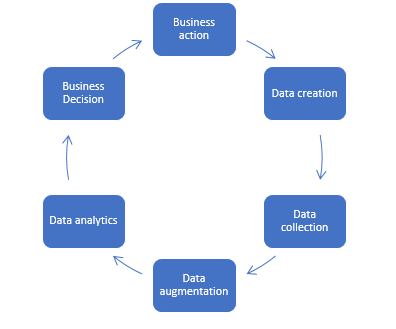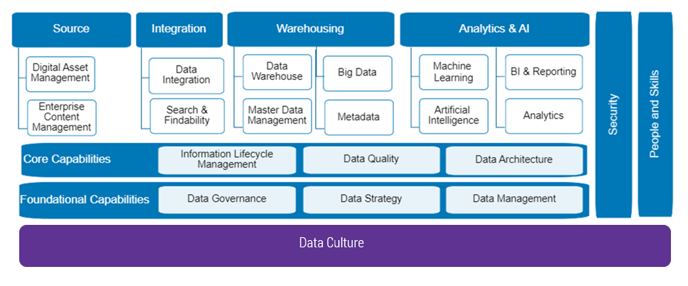
In this special guest feature, Natalia Modjeska, Research Director, Applications – Data & Analytics at Info-Tech Research Group, provides best practices and use case examples of how businesses are leveraging data and analytics to address pandemic challenges and move beyond “survival mode.” Natalia joined Info-Tech in June 2017 as Director, Research and Advisory for DnA (Data & Analytics). She brings more than 15 years of experience in developing, selling, and implementing analytical technologies and solutions to support business objectives. This experience includes advising organizations on how to drive more value from their existing investments in data, technologies, and people and from emerging capabilities (e.g., AI).
The pandemic has shown that data and analytics are no longer optional. They are mandatory for survival amid this massive, disruptive and ongoing change that is quickly becoming the new normal – because they provide business leaders with the ability to make informed decisions to ensure business continuity, understand the shifting needs of their customers, and protect employees, consumers, and citizens.
“Data”, said Dr. Tom Frieden, former director of the US Centers for Disease Control and Prevention, “is a ‘very powerful weapon against this virus’ … Data can help stop outbreaks from turning into epidemics”. In fact, BlueDot, a Canadian company that uses natural language processing to analyze online information in 65 languages, warned of the outbreak on December 31, 2019, days ahead of the CDC and the WHO.
Data and analytics are being used to predict, visualize, and track the rate of novel coronavirus infection, hospitalization, mortality and survival and to manage precious hospital resources: from ER and ICU capacity, to ventilators, PPE and medical personnel.
Interactive dashboards such as John Hopkins’ COVID-19 Dashboard have been helping policymakers from the start of the epidemic to create informed response initiatives. John Hopkins data is so timely that “it often reports countries’ first cases before local health authorities do”. It quickly became a de facto authority on the status of the pandemic and a familiar, if morbid, feature across news sites and TV stations around the world.
Interactive infection maps like the one by the City of Toronto help contain the spread of the disease by surfacing infection data at neighborhood level and thus reminding the residents to take precaution in this time of quarantine fatigue and more lax behavior.
Early on, artificial intelligence and machine learning were also recruited to fight COVID-19: from detecting visual signs of COVID-19 pneumonia from images from lung CT scans, to using cameras equipped with thermal sensors to identify people with fever. More crucially, AI/ML (and the data they depend upon) have been indispensable in analyzing the virus genome for vaccine creation; in automating the design and testing of virtual molecules to create drugs to treat the disease; and for mining scientific literature for possible cures.
And this is just scratching the surface of the many cases where data, analytics and AI/ML are being used to fight the pandemic.
In business, the pandemic has created an unprecedented near-real-time demand for data and analytics across all industries. Business stakeholders of all levels are using data and analytics to understand what their customers, consumers, citizens, employees, and partners need now and to anticipate what they will need in the near future in order to be ready and pivot (again) as needed.
Retailers, for example, are continuously analyzing consumer purchasing behavior to predict demand, manage inventory and handle reordering, as well as to manage store associates.
Educational institutions — another sector very heavily hit — leveraged data early on in the pandemic to assess the financial impact and implications of sustained lock-downs, as well as those of alternative education delivery methods, such as remote teaching and learning. Many are also using analytics for faculty and facility management.
In manufacturing, analytics helped to pivot to new products, assess the impact of plant closures, model cash flow liquidity and debt obligations, manage workforce and suppliers including finding alternatives.
Digitally-savvy and analytically mature organizations realized early on that analytics, especially predictive analytics, is as close as one can get to having a crystal ball, especially in these times of uncertainty and crisis. They know that analytics is the only way to:
- get timely insights into operational performance;
- uncover emerging trends to inform new tactics and business models;
- simulate outcomes; evaluate options, scenarios, and constraints; and model their impact;
- test the efficacy of new approaches;
- measure the Impact of new tactics and interventions;
- course-correct or pivot the business when needed;
- and, above all, minimize uncertainty and risk.
Because organizations, like individuals, abhor uncertainty. Uncertainty is disorienting, it is frightening, and it can be devastating. (It can also mean tremendous opportunities.) Analytics reduces uncertainty – it helps to predict the future, measure how well we are doing compared to where we want to be, and learn from the past in order to prepare for the future to come.
While some organizations have struggled, many have gone beyond pure survival. – They are leveraging data, analytics, and AI/ML to innovate and create their own future. What do they have in common, and what can we learn from them?
We see consistently that pandemic survivors are agile, creative, and that they are thinking outside of functional, cultural and procedural boxes and siloes. They recognized very quickly that speed is of the essence and pivoted, forming cross-functional IT and business teams who work side by side relentlessly iterating like there is no tomorrow. (Because there may not be one.) They collaborate and learn from each other. They found a way to bypass legacy request intake processes and learned to work directly with the users who need analytics not tomorrow but today.
They have left behind the legacy of thinking linearly:

And moved instead to agile, iterative, and collaborative co-creation:

These survivors treat data and analytics as if they were the central nervous system of their organizations. Because they know that data and analytics are a means to know how to respond, that data and analytics help people to think. They know that data and analytics can help you steer your organization through the storms of the pandemic. And for some, they also help to go beyond survival: to help reimagine the future and position themselves to thrive in the new normal. Or even to create that future.
Most importantly, these pandemic survivors are succeeding because they stand on the foundation of effective, mature data management and organizational culture that treats data as a valuable enterprise asset – the only one that provides a reliable view into the health of the business and customer needs.

But even less-mature organizations were able to mobilize in the early stages of the pandemic and quickly delivered insights that their stakeholders needed. For example, early on in the pandemic, a municipal government in Canada built a solution to integrate data from their many agencies to monitor PPE inventory levels and requests and to centralize orders. This enabled them to better protect employees and residents. Now, with the economy reopening (and possibly contracting again), they are using data and analytics to track and manage their 5,000 workforce, especially essential employees who cannot work from home. This ensures that the government can continue to deliver much needed services while protecting employees and preventing transmission.
What about you and your organization? Where do you stand? How has your organization fared in the crisis? Should you invest severely limited funds in enhancing your data management and analytics capability? We hope that we have convinced you that the question is no longer “if”, but how fast you need to move to do this. The answer, of course, depends on several factors, says my co-worker and fellow analyst Igor Ikonnikov:
- Your current maturity level;
- The size and diversity of your operations/business lines;
- The degree of disruption happening in your industry/sector, as well as the fierceness of competition among your peers;
- Your business aspirations:
- To just retain your position relative to your peers,
- Ensure crisis-proof position, or
- Pull ahead of your competition.
So, consider doing this quick self-assessment, continues Igor:
- Do you know exactly what is happening in every part of your organization and can you analyze your historical and operational data? I would also add: How close to real time can you do it? Not only is this time a time of massive information deficit, it is also a time of massive data shift. – The data you collected yesterday may not be useful tomorrow, as consumer behaviors have changed and they continue changing.
- Can you identify products, services and internal processes that need tweaking or improving?
- Do you know your position relative to your competition — and are you actively monitoring it?
- Can you anticipate shifts in customer behavior and in your industry/sector (to the extent it is possible in these times of dramatic disruption)?
- Do you know what needs to be done? Can you test your business hypotheses on the relevant and timely data? (And let’s not forget about data quality.)
If the answers to the above are “no” or “maybe” or “kind of”, now is the time to invest in a solid foundation of data and analytics, to modernize your existing data management and analytics capabilities, and – unless you are already doing that — invest in more advanced capabilities such as predictive, data science and perhaps AI and machine learning.
Like all crises before it – the financial crisis of 2008-09, the Y2K, etc. — the COVID-19 pandemic may have revealed your flaws and deficiencies. But it also gave us all a gift: an opportunity to rethink, re-evaluate, re-invent, and re-invest. To modernize, mature and evolve our enterprises. We should leverage it to strengthen the foundation of organizational decision making, and perhaps to finally transform from using analytics as decision support (or decision “influencer”) and to the framework for decision making.
Let us use the lessons learned from COVID-19 pandemic survivors and pandemic “stars” to rethink and reimagine data and analytics strategy and investments. We need these capabilities to support and empower stakeholders of all kinds who are building the future, today. There is no time to waste.
Sign up for the free insideBIGDATA newsletter.




Speak Your Mind